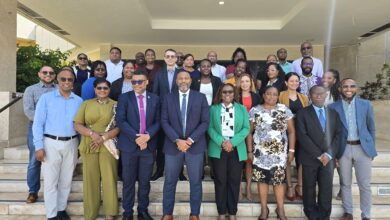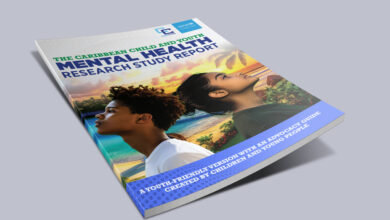|
Salutations. This new publication, Our Caribbean Community – An Introduction, targeted at young readers, appropriately written in simple, straightforward language, is a timely and most welcome addition to the growing body of literature about the maturing regional integration movement of the Caribbean people. It is indeed most fitting that this first effort of its kind is a product of the CARICOM Secretariat, charged as it is not only with the administrative management and the implementation of decisions, but also with the generation of proposals for Community action and development. This publication can make a very special contribution, as we seek to engage the people of the region in a fresh and meaningful dialogue which is not confined to the Meetings of Heads of Government or technical exchanges among our officials. Our people need to be engaged at the level of the streets, homes, offices, classrooms, sports-grounds, bars, shops, churches, boardrooms, factories, in all Member States. As the regional integration process progresses, there remains an overriding need to engage our Caribbean citizens in an open and honest discussion about who we are as a Community of people. They need to understand why greater unity among ourselves is an inescapable necessity. They want to be convinced about the practical benefits that we will derive from ever closer regional economic and social collaboration. The contemporary demands and challenges of today’s world make a compelling case for the rationalising and harmonising of our economic systems and social institutions. Developing geopolitical trends portend even greater challenges to come, make regional economic integration an inevitable direction. CARICOM IN THE CONTEXT HISTORY My firm commitment to our development as a region, is based on a recognition that our Community has been forged out of a common human experience; a conviction that commonality of displacement, fragmentation and the development of a dynamic, vibrant Caribbean existence and culture constitute the foundations of our shared regional identity. We are a chain of islands and sub-continental landscapes woven into a quilt of shared geographic space, and endowed with a unique texture of a unique Caribbean blend fomented by our achievements and aspirations which are the same from Suriname in the South to the Bahamas in the North. From Belize to Barbados the region flows with our people’s blood, sweat and tears. We must advance and nurture our collective identity through deeper, more profound integration. We have nothing to lose, and everything to gain, from strengthening understanding, identity and contact between our people as we advance CARICOM integration. Throughout history, the human element of our togetherness has been the most enduring. In a sense, the institutional underpinnings of regional integration have never been able to keep pace with the dynamics of the people’s own practical collaboration and assimilation. Increasingly, we have come to accept at the political level that we have to crown the efforts of our people with even bolder actions by our Governments and more effective implementation by our institutions. The Leaders in all areas of our Community – in business, politics, academia and the wider society – must buttress the desires of our people by making even greater efforts to make a practical reality the mechanisms and opportunities for the deepening of integration efforts on their part. It is in this context that we can appreciate the importance of an institution such as the University of the West Indies; or an agreement such as that enabling the portability of pension benefits; as well as the decision taken by Heads of Government in Trinidad earlier this month to expand the categories of CARICOM nationals eligible for free movement within the Community beyond those already approved – and include additional artisans categories of workers as proposed by the Caribbean labour movement. I am indeed heartened by our achievements – although there clearly is much more to be done. The Caribbean architecture that was dreamt of by the pioneers from as early as 1947 in Montego Bay, and given form at Dickenson Bay, Chaguaramas, Grand Anse and Rose Hall, is beginning to take even more strikingly definitive shape in a way that effectively intersects with the dreams, hopes, aspirations and integration efforts of our Caribbean people. In a world of fast-changing geo-political realities and radically altered economic priorities on the part of the developed countries, the danger of small states like ours being marginalized looms larger. Nothing short of mature regionalism, embedded in proper, effective institutional arrangements and a functioning and beneficial economic convergence will avoid this. The maturing of our integration process through greater focus on people-centred economic approaches and the strengthening and re-orientation of regional institutions, to impact directly and positively on the lives of our people, is vital for mitigating our vulnerability in many respects. Not least of these areas are natural disasters, as has been so clearly and devastatingly illustrated by the volcano in Montserrat, or Hurricane Ivan and most recently, by the earthquake in Dominica. As small developing states, we are also vulnerable in the economic sense. We must increase our individual and collective productive base and our capacity to compete effectively in world trade as well as in international financial services. The single market and economy offers this kind of mitigation. We have to utilize the CSME to expand output and employment in all Member States as we adjust to hemispheric and global liberalization. It is for this reason I am positive that the 2005 timeline for the completion of the CARICOM Single Market is not a day too soon, and why Jamaica, Barbados and Trinidad and Tobago have opted to fast-track our CSME-readiness to the end of this year. The CSME will have far-reaching implications for our region, our people, our businesses. Already, the elements of the Single Market that are in place have given rise to profitable trans-Caribbean businesses. These enterprises have solidified their operational base in CARICOM as a launching pad for effective initiatives in the wider international markets and economies. As we move ahead with the CSME, as we seek to further involve all our people, their ideas, their talents and creativity as we seek to advance our progress as a region, I must remind this audience that CARICOM as a mature regional integration entity still needs a mechanism to effectively harness the support of our Caribbean people in the Diaspora. We need to provide them with channels of reliable and useful information. We have to enlist their abundant loyalty, goodwill and support for Caribbean development in a formal way. Twelve years after the West Indian Commission Report, we are yet to devise formal methodologies for tapping the overseas capital market through attractively packaged bond issues targeting the Caribbean Diaspora. Such capital inflows could be directed towards specific development needs in the region such as the modernizing, restructuring and strengthening of regional air transport, with the multiplier effect that such a move would provide. THE BOOK On perusing the book, one is immediately struck by the symbolic and substantive relevance of starting an important publication such as this by unequivocally establishing the identity of “Our Caribbean”. This initial chapter, which traces the outline of our social, economic and political history, highlights the ever-unfolding culture of our peoples; and which speaks to the nature and potential of the region’s resources – both human and natural, is a powerful foundation for the book and for a proper understanding of its objectives. CARICOM: Our Caribbean Community – An Introduction presents the background to the Community; explains the workings of its Pillars, Organs and Institutions; and offers suggestions on the way forward for us as a Community, in a manner that leaves the reader to make their own assessment of the worth and work of CARICOM, its viability and the logic of advancing the integration movement. I am pleased to be associated with this publication and delighted to have the honour of declaring duly launched, the book, CARICOM: Our Caribbean – An Introduction. This is an incisive, insightful and valuable contribution to Caribbean self-assessment and to a universal understanding of our peoples, our history, our achievements, our challenges and our future. CONCLUSION Our Community has come a long way. There have been important gains, and greater gains are yet to come. They may not all come while I am still at the crease, but if we consistently apply ourselves to the tasks at hand, this generation and generations to come will see the fruits of all our labours. While we ponder our achievements and summon the resolve to complete unfinished business, I congratulate the CARICOM Secretariat for its move to illuminate our path with this reader, Our Caribbean Community – An Introduction. It marks a welcome beginning and a good opening stroke as we endeavour to increase the levels of communication among our people and to fashion a modern edifice for this Community of ours. It is a privilege for me to officially launch this new publication. |
|
Press ReleasesSpeeches





